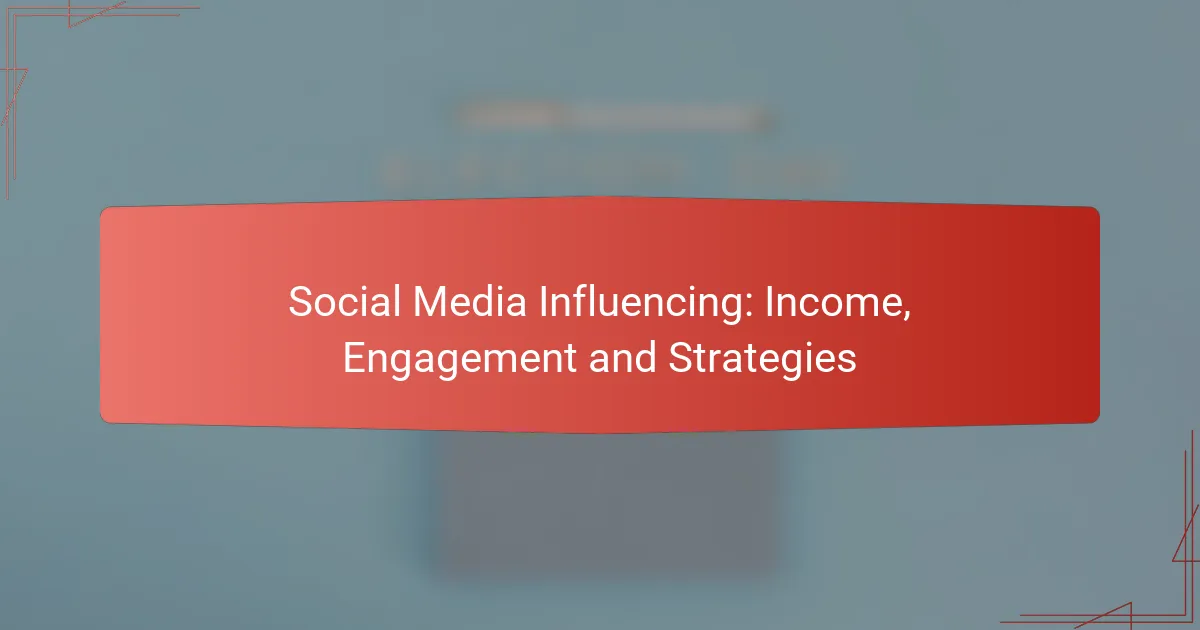Social media influencing has become a lucrative career path, with influencers employing various strategies to enhance their income through brand partnerships, affiliate marketing, and merchandise sales. To maximize engagement, effective influencers create meaningful interactions with their audience using techniques like interactive content and live streaming. With platforms like Instagram, TikTok, and YouTube offering unique features and high engagement rates, influencers can tailor their content to resonate with diverse audiences.

How can social media influencers increase their income?
Social media influencers can boost their income through various strategies, including brand partnerships, affiliate marketing, sponsored content, and merchandise sales. Each method offers unique opportunities and challenges, allowing influencers to diversify their revenue streams.
Brand partnerships
Brand partnerships involve collaborating with companies to promote their products or services. Influencers typically negotiate contracts that outline deliverables, compensation, and timelines. Successful partnerships can lead to significant income, often ranging from hundreds to thousands of dollars per post, depending on the influencer’s reach and engagement.
When pursuing brand partnerships, it’s crucial to align with brands that resonate with your audience. Authenticity is key; followers can quickly detect insincerity, which may harm both the influencer’s reputation and the brand’s image.
Affiliate marketing
Affiliate marketing allows influencers to earn commissions by promoting products and directing their followers to purchase through unique links. This model can be lucrative, especially in niches like fashion, beauty, or tech, where influencers can earn a percentage of sales, typically ranging from 5% to 30%.
To maximize earnings, influencers should choose affiliate programs that offer competitive commissions and products their audience genuinely values. Regularly sharing honest reviews and personal experiences can enhance trust and drive conversions.
Sponsored content
Sponsored content involves creating posts or videos that feature a brand’s product, typically in exchange for payment. This can include social media posts, blog articles, or videos that highlight the product’s benefits. Compensation varies widely, often depending on the influencer’s follower count and engagement rates.
When creating sponsored content, it’s essential to maintain transparency with your audience. Clearly labeling posts as sponsored helps build trust and complies with advertising regulations, such as the FTC guidelines in the U.S.
Merchandise sales
Merchandise sales enable influencers to sell their branded products directly to their audience. This can include clothing, accessories, or digital products like e-books or courses. The potential income from merchandise can be substantial, especially if the influencer has a loyal following.
To succeed in merchandise sales, influencers should focus on quality and design that resonate with their brand identity. Utilizing platforms like Shopify or Etsy can simplify the selling process, allowing influencers to reach a broader audience while managing inventory effectively.

What engagement strategies work best for influencers?
Effective engagement strategies for influencers focus on creating meaningful interactions with their audience. By leveraging techniques such as interactive content, live streaming, and audience polls, influencers can enhance their connection with followers and boost overall engagement rates.
Interactive content
Interactive content includes quizzes, games, and challenges that invite audience participation. This type of content encourages users to engage actively rather than passively consuming information, leading to higher retention and sharing rates. For example, a fashion influencer might create a style quiz that helps followers choose outfits based on their preferences.
To maximize impact, ensure that interactive content is visually appealing and easy to navigate. Incorporating elements like user-generated content can also enhance engagement, as followers feel more connected to the influencer’s brand.
Live streaming
Live streaming allows influencers to connect with their audience in real time, fostering a sense of community and immediacy. During live sessions, influencers can answer questions, showcase products, or share experiences, making followers feel involved and valued. This format often leads to higher engagement rates compared to pre-recorded content.
To effectively utilize live streaming, plan engaging topics and promote the event in advance. Consider using platforms popular in your target market, such as Instagram Live or Facebook Live, to reach a wider audience. Aim for consistency by scheduling regular live sessions to build anticipation among followers.
Audience polls
Audience polls are a straightforward way to gauge follower opinions and preferences. By asking questions related to content, products, or trends, influencers can gather valuable insights while making followers feel heard. Polls can be conducted through stories, posts, or dedicated apps, and they often encourage further discussion in the comments.
When creating polls, keep questions clear and concise to maximize participation. Use the results to inform future content or product offerings, demonstrating that you value your audience’s input. Regularly incorporating polls can help maintain engagement and foster a sense of community among followers.

Which platforms offer the highest engagement rates?
Platforms like Instagram, TikTok, and YouTube consistently show high engagement rates, making them popular choices for influencers. Each platform has unique features that cater to different audiences and content types, impacting how users interact with posts.
Instagram is known for its visually driven content, which fosters high engagement through likes, comments, and shares. Influencers can leverage features like Stories, Reels, and IGTV to connect with their audience in various ways. Engagement rates often range from 1% to 5%, depending on the niche and follower count.
To maximize engagement on Instagram, focus on high-quality visuals and authentic storytelling. Posting consistently and utilizing relevant hashtags can also help reach a broader audience. Avoid over-posting, as it may lead to follower fatigue.
TikTok
TikTok has rapidly gained popularity due to its short-form video content, resulting in some of the highest engagement rates among social media platforms. Users often spend significant time on the app, leading to engagement rates that can exceed 10% for well-crafted content. Trends and challenges play a crucial role in driving interactions.
To succeed on TikTok, create entertaining and relatable videos that resonate with your target audience. Engaging with trends and using popular sounds can enhance visibility. Don’t forget to interact with comments to build a community around your content.
YouTube
YouTube offers a different engagement dynamic, primarily through longer video formats. While engagement rates are typically lower than on Instagram and TikTok, they can still be substantial, especially for niche content. Rates often hover around 1% to 3%, but loyal subscribers can drive higher interactions.
For effective engagement on YouTube, focus on creating valuable content that encourages viewers to comment and share. Consistent posting schedules and engaging thumbnails can attract more views. Remember to respond to comments to foster a sense of community and loyalty among viewers.

What metrics should influencers track for success?
Influencers should focus on key metrics that reflect their effectiveness and growth, including engagement rate, follower growth, and conversion rate. These metrics provide insights into audience interaction, popularity, and the ability to drive desired actions.
Engagement rate
Engagement rate measures how actively your audience interacts with your content, typically calculated as the total interactions (likes, comments, shares) divided by the total followers, expressed as a percentage. A high engagement rate indicates that your content resonates well with your audience.
Influencers should aim for an engagement rate of around 1% to 5%, depending on the platform and niche. For example, micro-influencers often see higher engagement rates compared to those with larger followings.
To improve your engagement rate, focus on creating authentic content that encourages interaction, such as asking questions or running polls. Avoid posting solely promotional content, as this can lead to lower engagement.
Follower growth
Follower growth tracks the increase in your audience size over time, which is crucial for expanding your reach. This metric can be assessed weekly or monthly to identify trends and the effectiveness of your content strategy.
Healthy follower growth varies by platform; for instance, a growth rate of 5% to 10% per month is often considered strong on Instagram. However, rapid growth can sometimes indicate the use of bots or fake accounts, which can harm credibility.
To boost follower growth, engage with your audience through comments and collaborations, and utilize relevant hashtags. Regularly analyze which types of posts attract new followers to refine your strategy.
Conversion rate
Conversion rate measures the percentage of your audience that takes a desired action, such as clicking a link, signing up for a newsletter, or making a purchase. This metric is vital for assessing the effectiveness of your promotional efforts.
A typical conversion rate for social media influencers can range from 1% to 3%, depending on the industry and the call-to-action used. Higher rates often result from targeted campaigns and clear messaging.
To enhance your conversion rate, ensure that your calls-to-action are compelling and relevant to your audience. Test different approaches, such as limited-time offers or exclusive content, to see what resonates best with your followers.

How do influencers build their personal brand?
Influencers build their personal brand by creating a unique identity that resonates with their audience, often through a combination of consistent content, authentic storytelling, and engagement strategies. This process involves showcasing their personality and values in a way that attracts and retains followers.
Consistent content theme
A consistent content theme helps influencers establish a recognizable brand identity. By focusing on specific topics or niches, such as fashion, travel, or fitness, influencers can attract a targeted audience that shares similar interests. This consistency also aids in building trust, as followers know what to expect from the influencer’s content.
To maintain a consistent theme, influencers should create a content calendar that outlines their posting schedule and topics. This can include daily posts, weekly series, or monthly themes. For example, a travel influencer might post destination guides every Monday and travel tips every Thursday.
Authentic storytelling
Authentic storytelling is crucial for influencers to connect emotionally with their audience. By sharing personal experiences, challenges, and successes, influencers can create a relatable narrative that engages followers. This authenticity fosters a sense of community and loyalty among their audience.
To enhance their storytelling, influencers should focus on being genuine and transparent. They can share behind-the-scenes moments, candid thoughts, or even failures, which can resonate more deeply than polished content. For instance, a beauty influencer might discuss their skincare journey, including struggles with acne and the products that helped them.

What are the prerequisites for becoming a successful influencer?
To become a successful influencer, you need a clear understanding of your niche, strong content creation skills, and the ability to engage with your audience effectively. These elements are essential for building a loyal following and monetizing your influence.
Niche selection
Niche selection is crucial for establishing your brand as an influencer. Choose a specific area of interest that aligns with your passions and expertise, whether it’s fashion, travel, fitness, or technology. A well-defined niche helps attract a targeted audience and makes it easier to create relevant content.
Consider the competition within your chosen niche. Research existing influencers to identify gaps in the market or unique angles you can explore. This can help you differentiate yourself and provide value to your audience.
Content creation skills
Strong content creation skills are vital for engaging your audience and maintaining their interest. This includes photography, videography, writing, and editing skills. Invest time in learning these skills through online courses or practice to enhance the quality of your content.
Consistency in content quality and posting frequency is key. Aim to create a content calendar that outlines your posting schedule and themes. This helps keep your audience engaged and establishes your presence across platforms.

How do influencers negotiate brand deals?
Influencers negotiate brand deals by establishing clear expectations and terms that benefit both parties. This process often involves discussions about compensation, deliverables, and timelines to ensure alignment with the influencer’s audience and brand values.
Understanding the Brand’s Goals
Before negotiating, influencers should research the brand’s objectives and target audience. Understanding what the brand hopes to achieve—whether it’s increased sales, brand awareness, or audience engagement—can help influencers tailor their proposals effectively.
Setting Clear Deliverables
Influencers must define what they will provide in the partnership, such as the number of posts, types of content (e.g., videos, stories), and platforms to be used. Clear deliverables help avoid misunderstandings and ensure both parties have aligned expectations.
Determining Compensation
Compensation can vary widely based on the influencer’s reach, engagement rates, and the complexity of the campaign. Influencers should consider factors like their audience size and engagement metrics when discussing payment, which can range from a few hundred to several thousand dollars per post.
Building Relationships
Successful negotiations often hinge on building strong relationships with brand representatives. Influencers should communicate openly and professionally, fostering trust that can lead to long-term partnerships and better deals in the future.



